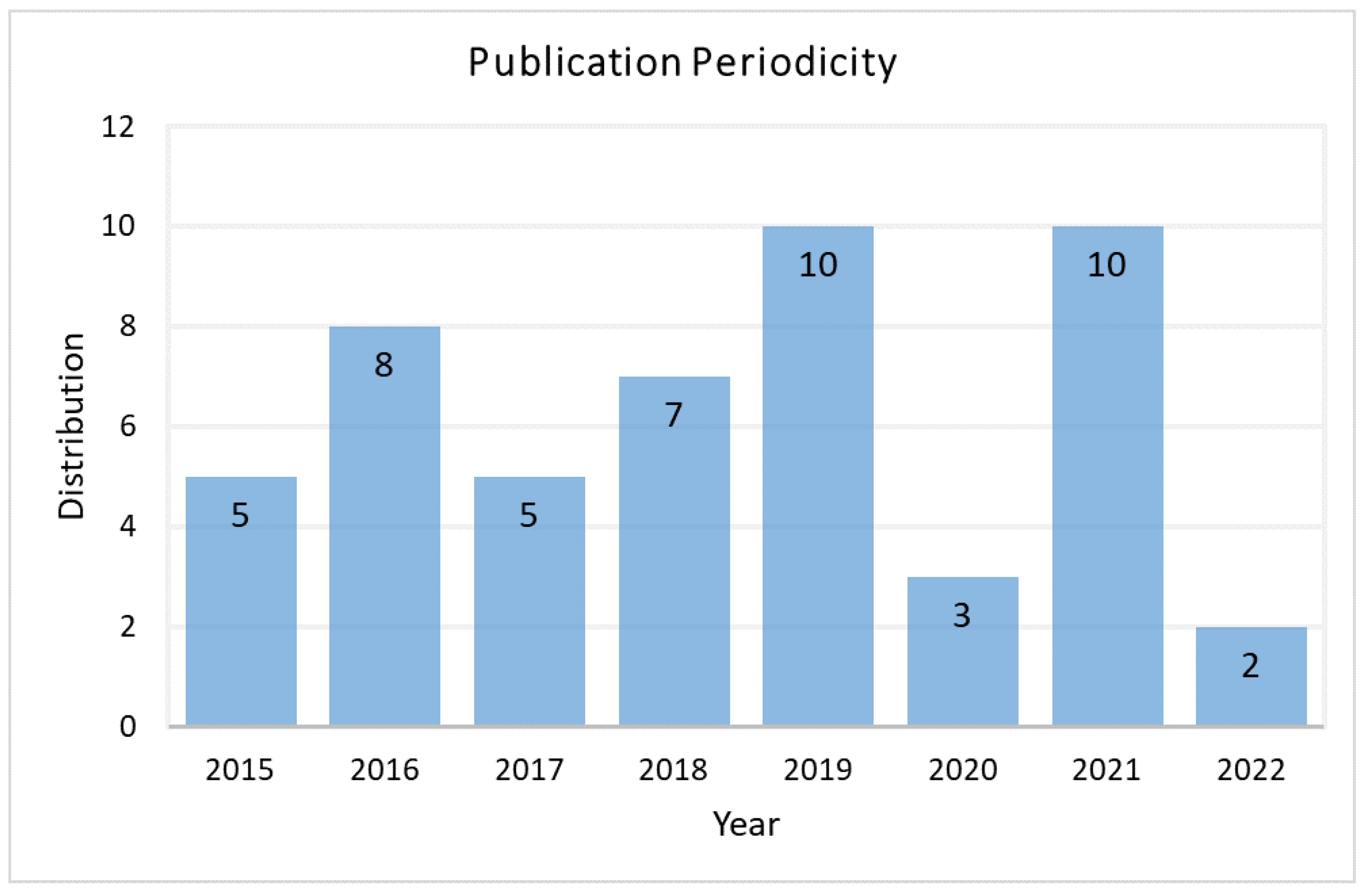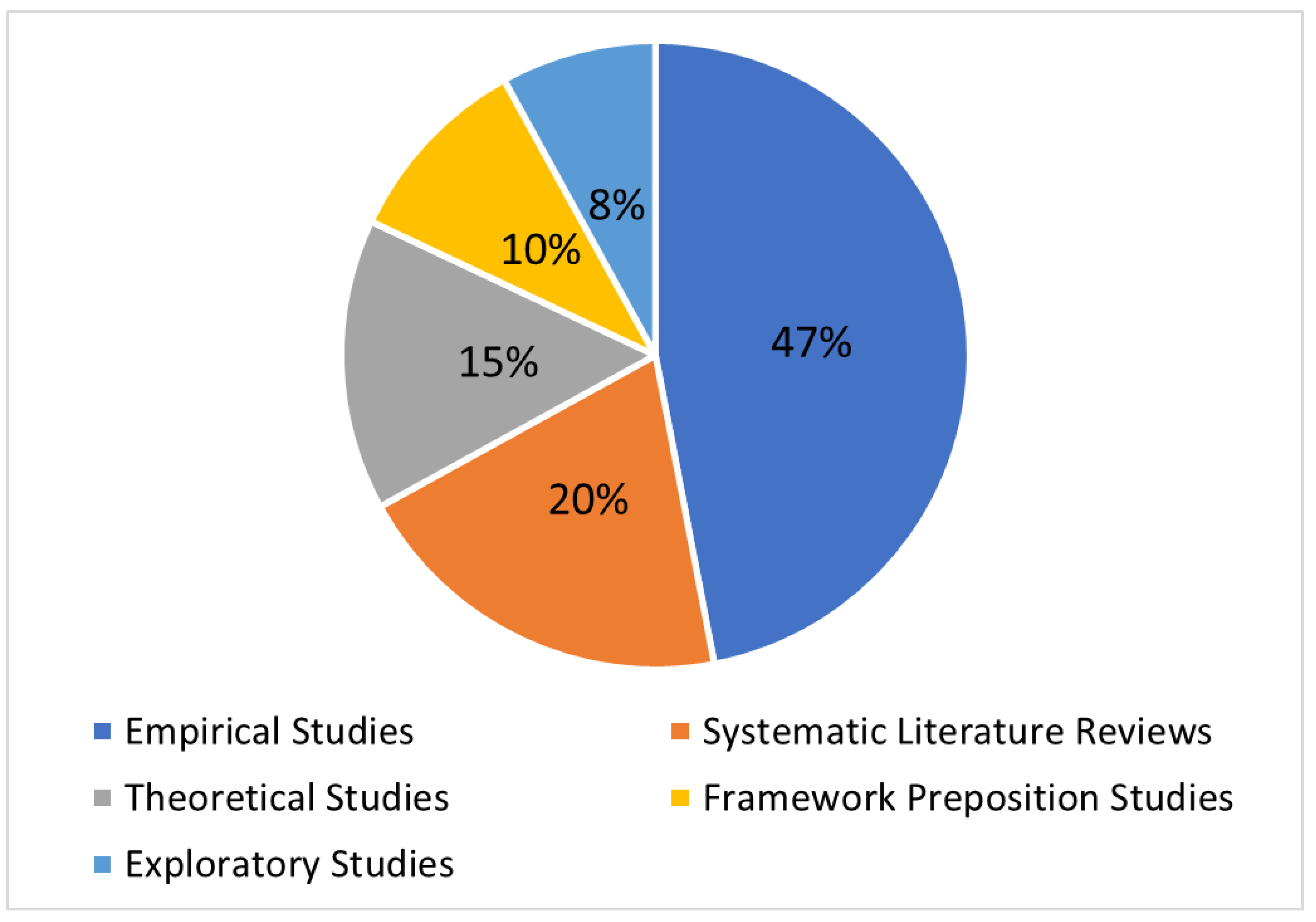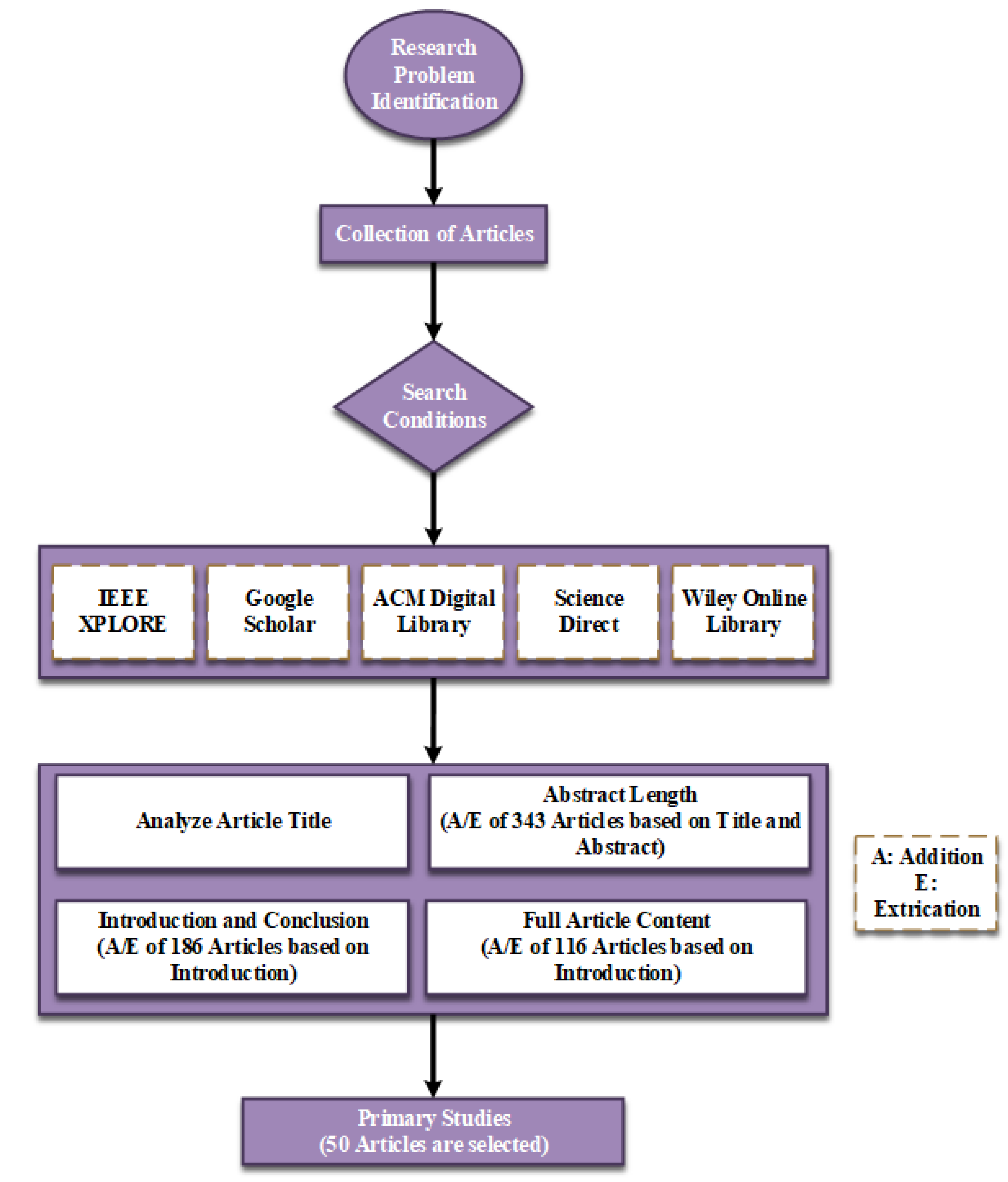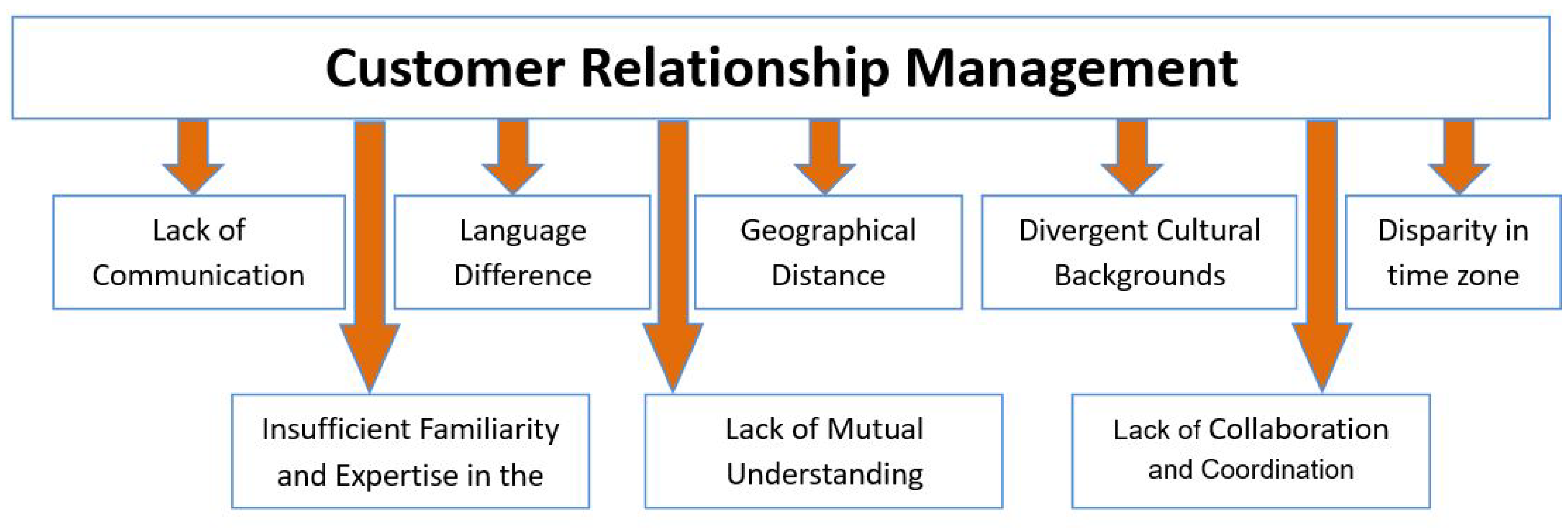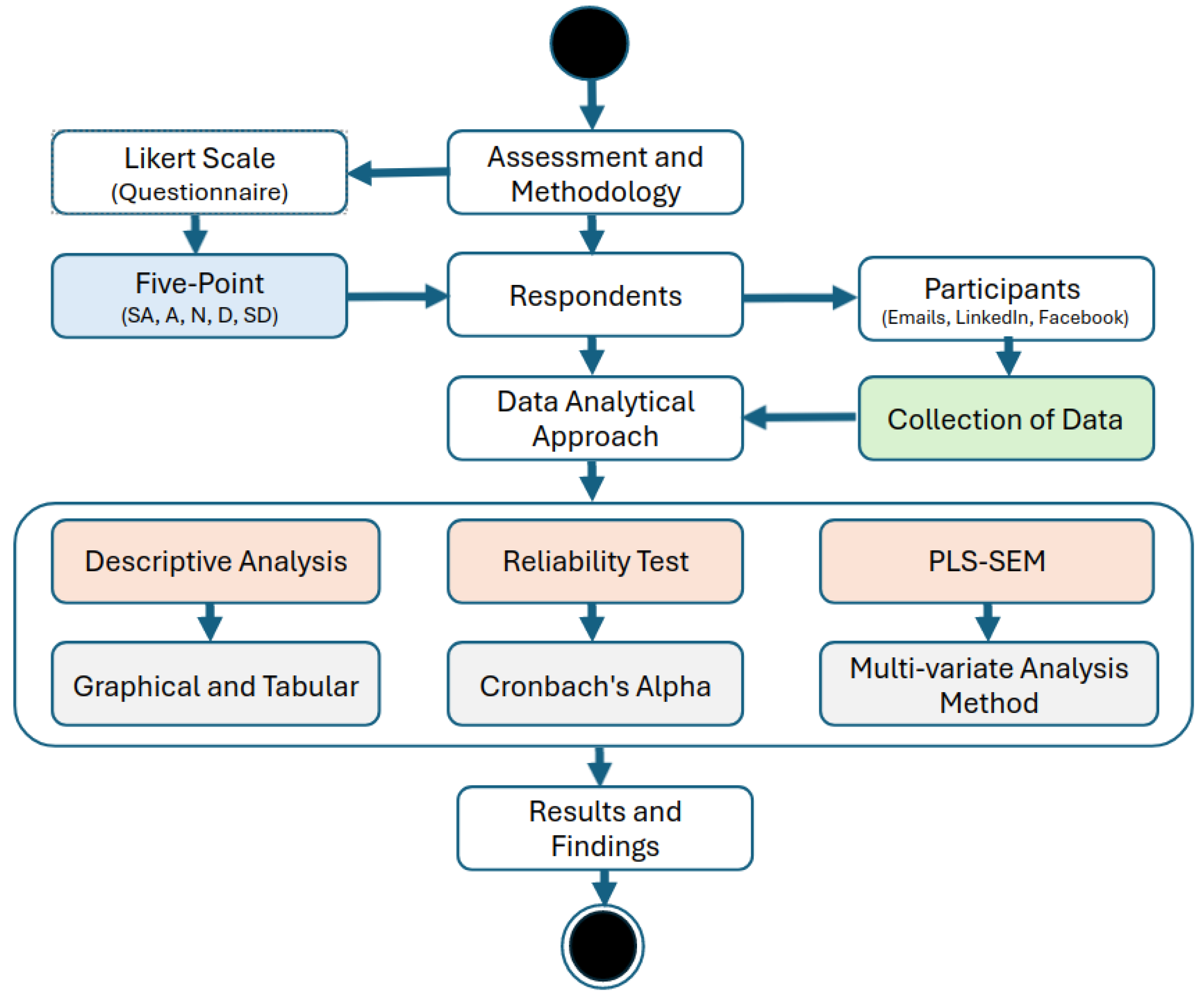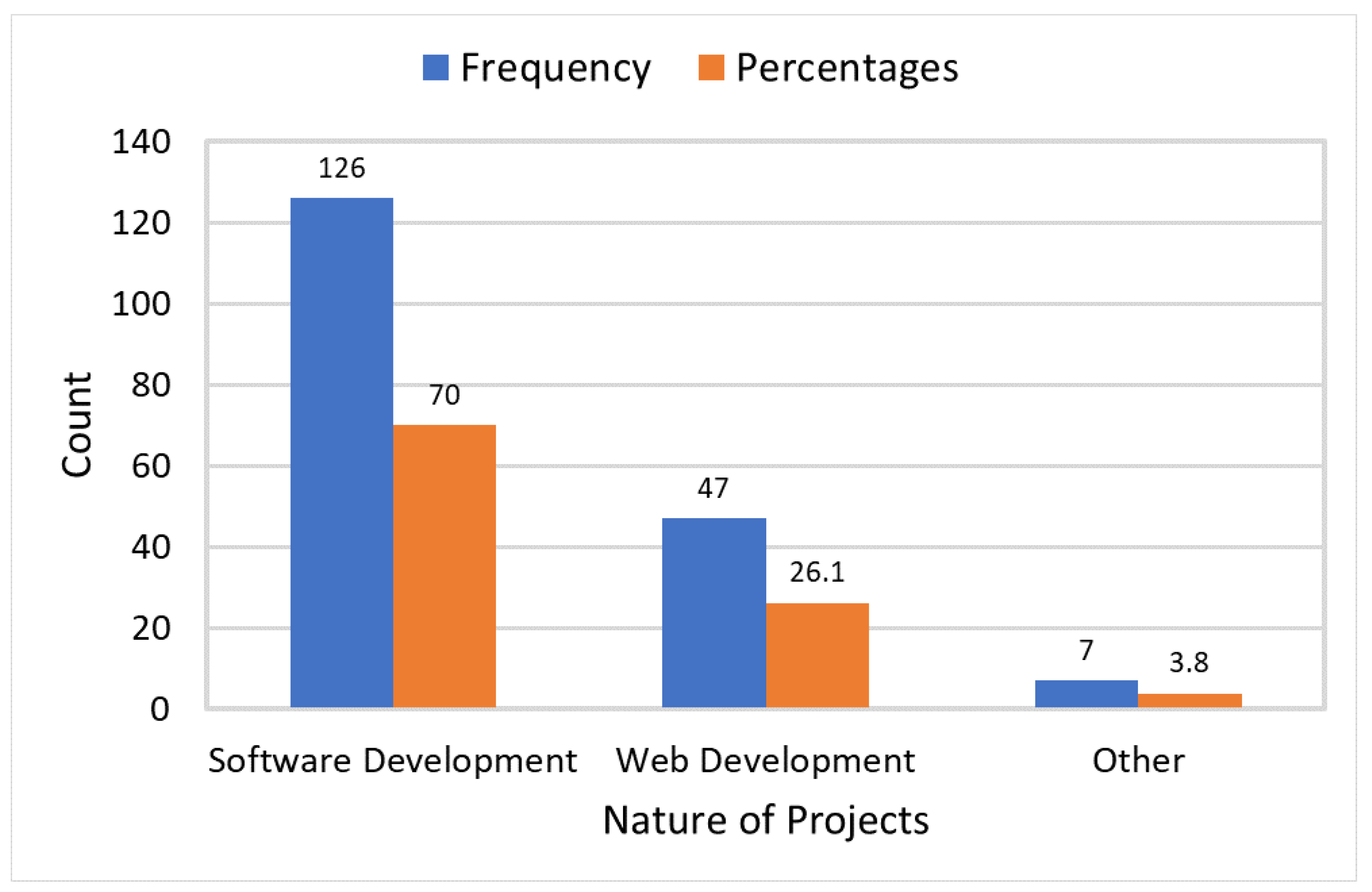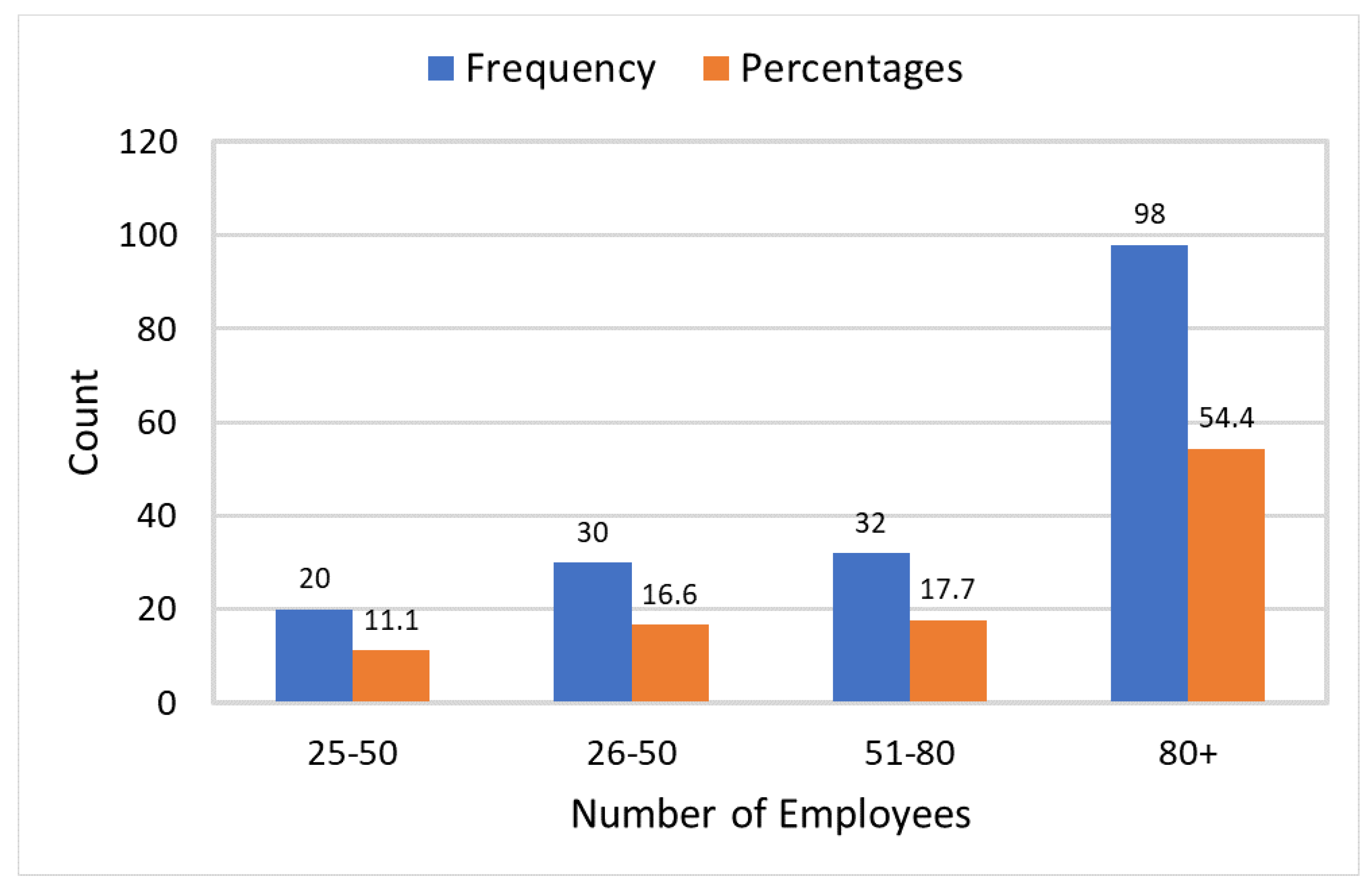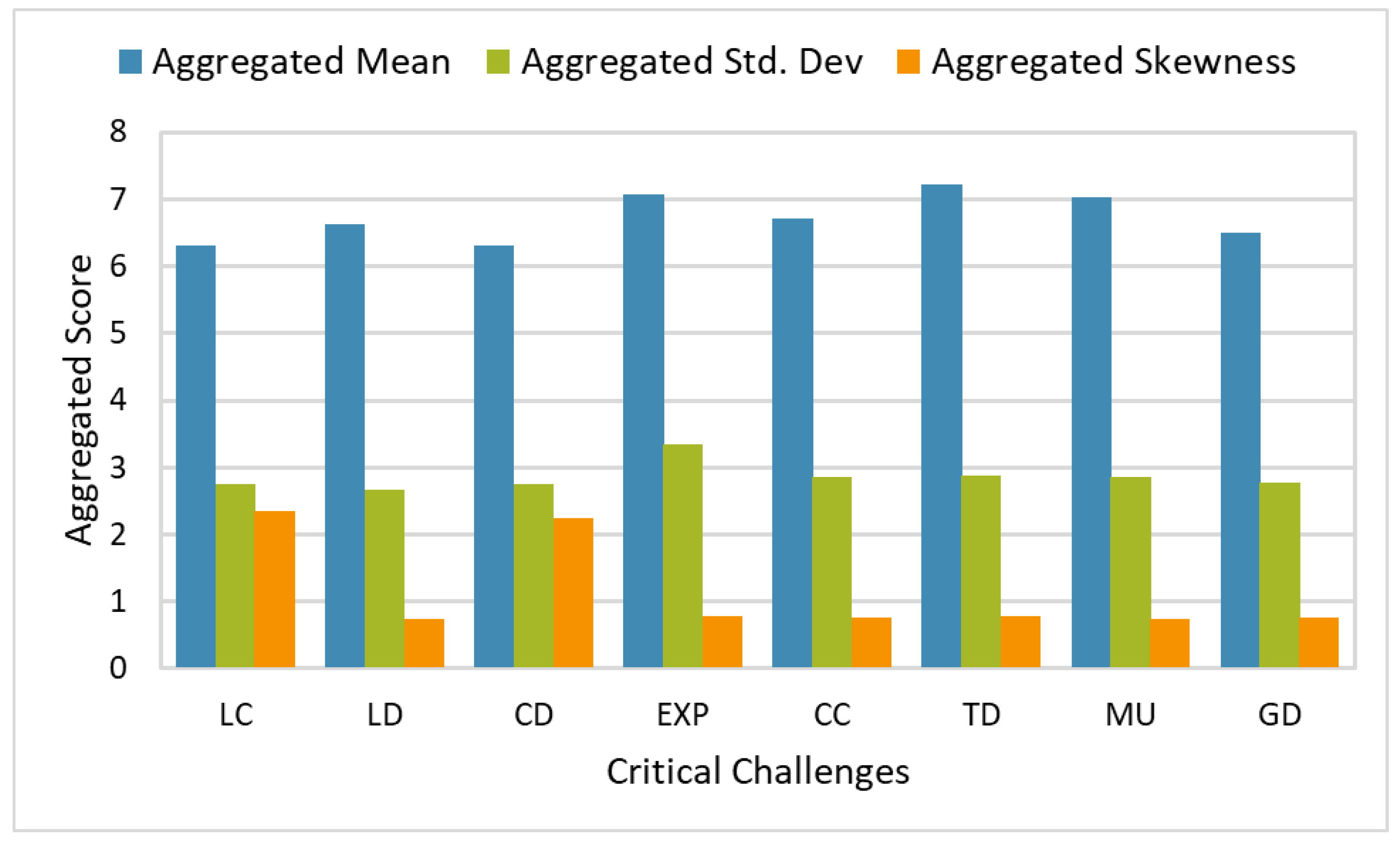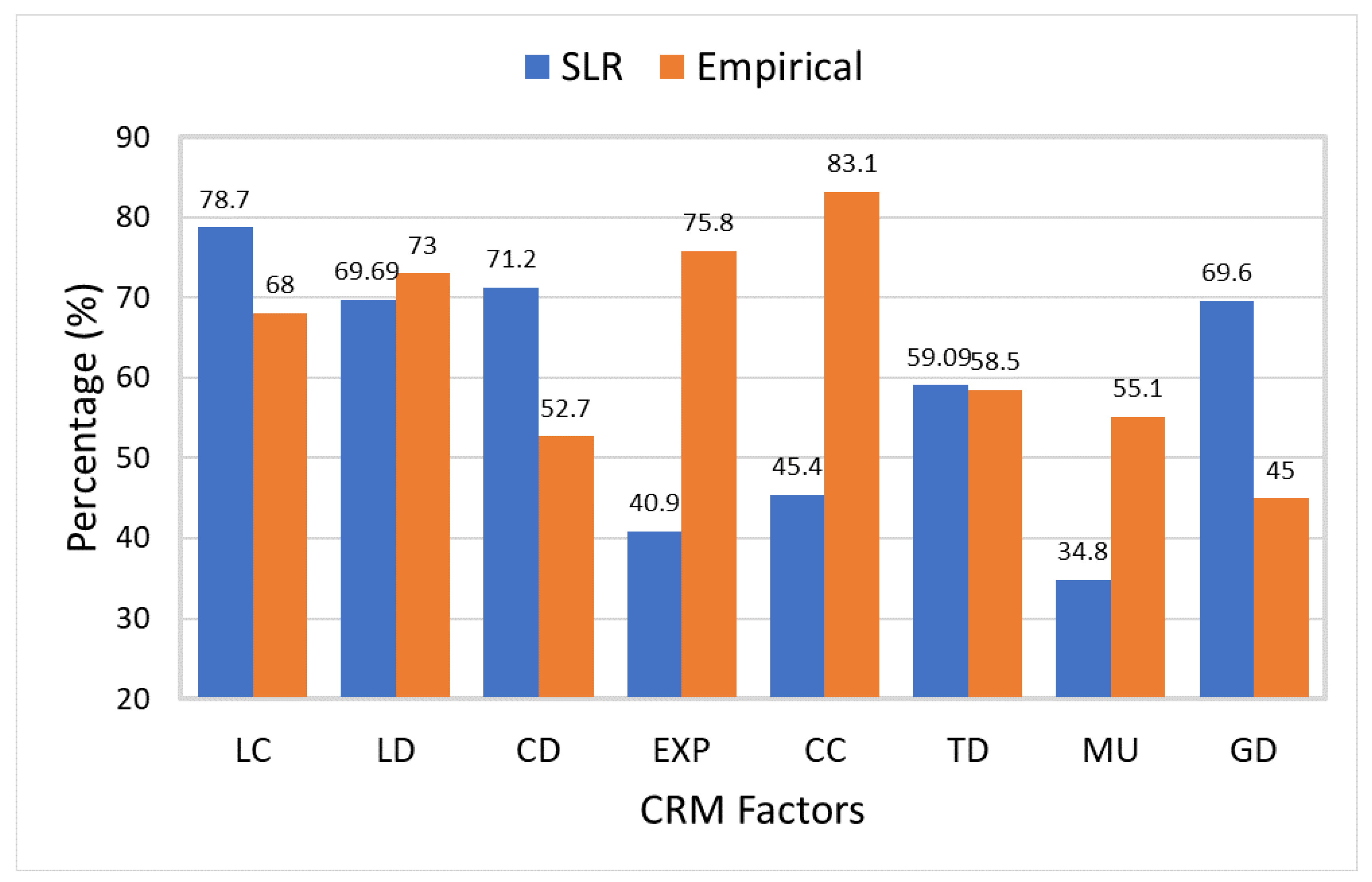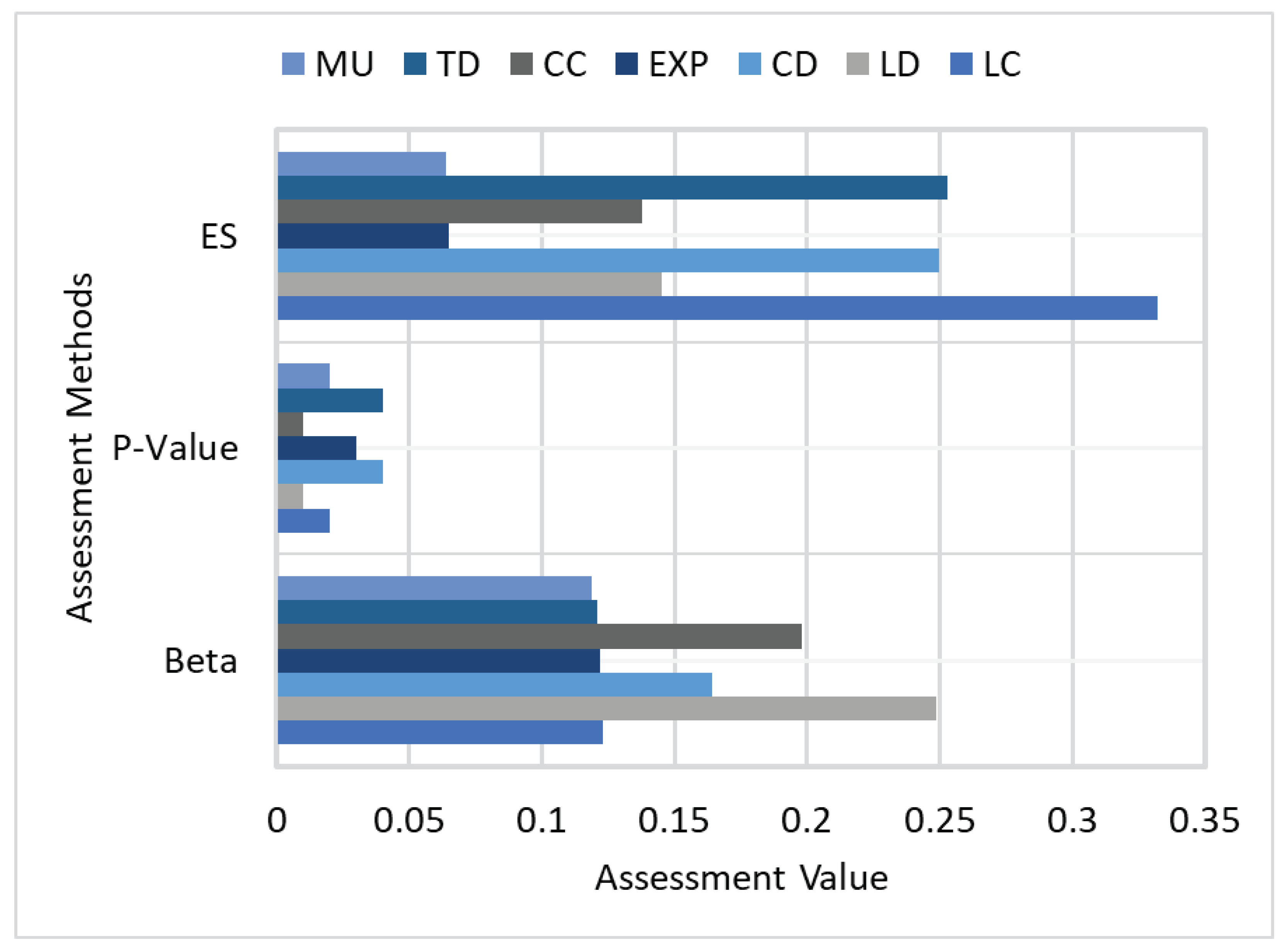1. Introduction
Global software development (GSD) is the term used to describe the fast-paced, cutting-edge, and efficient technologies that enable businesses to explore outsourcing and offer software project marketing [
1]. It is currently required in the software development cycle as well. Establishing the information technology (IT) influence on places and breaking it down geographically are cited by GSD [
2,
3]. The benefits of outsourcing include low costs, access to valuable resources, efficient scheduling, and continuous software development [
4,
5]. Despite abundant scientific proof in software engineering, there are several obstacles to outsourcing because of socioeconomic and civilizing differences. The variations above significantly impact project operations, coordination and collaboration, communication, and trust aspects in outsourcing. Furthermore, this issue has a negative impact on the success rate of projects [
6,
7].
Several developing countries, such as China, Pakistan, and India, have to deal with sophisticated marketing and outsourcing strategies in order to complete projects at comparatively low costs [
8]. In the future, outsourcing firms and various marketing activities will value the GSD quality system, which focuses primarily on customer satisfaction [
9]. Up to Now, outsourcing has caught the interest of users and other developers alike in producing great software on a smaller budget. However, that is to disclose many challenges because of the scattered consumers, geographically distributed partnerships, environmental backdrop, and socioeconomic and linguistic distinctions. In the framework of GSD, software-related initiatives are held to a high standard by renowned research subjects [
10]. The term standard is cited to the potential of software that attains consumers’ needs of functional and nonfunctional conditions [
11]. In addition to the software organization, the technical section introduces research and framework to enhance the project quality [
12]. The previously mentioned research clarifies the factors that impact the relationship management process. These studies shed light on the problems developers have with customers that affect customer relationship management (CRM). CRM problems have a detrimental influence on relationships between customers and organizations, particularly in companies operating in a GSD environment [
13]. The software production sector has noted that the quality of software projects can be enhanced by implementing maintenance and growth tactics [
14]. Different methods have been introduced from the customer satisfaction perspective to build on the software quality [
15].
Consequently, the vital stakeholders of any project are customers [
16], and the key to the success of any organization model is the customer relationship. Therefore, to significantly improve the software standard, the requirements management of the stakeholders is essential. A widespread subject of study among software development firms refers to managing CRM, which is also an active area of research among CRM academics in academia [
17]. CRM focuses on apps and forming a consortium to monitor and oversee relationships with current and future clients to improve client relations management and support trading magnification [
18,
19,
20]. Today, organizations try to grow businesses and aspire to boost their business. Consequently, the CRM structure possesses a foundation for client relation evaluation in the present marketing traffic by progressing client electronic data processing. The expectations of CRM structure could encourage software industries to enhance their relationship with their customers; in this way, industries will upgrade and expedite the reaction to the client’s demands [
21,
22].
Industries are pushed to outsource solutions to achieve high trading and marketing attention. Several obstacles, including racial disparities, topographic isolation by geography, and vernacular concerns, are faced by industries when using CRM while outsourcing in dispersed environments. The burgeoning application of CRM in outsourcing software development called for fully-fledged broad marketing and acquiring worthy dominance above the marketing contender. Probing and assembling the pertinent client’s knowledge, the CRM structure successfully purveys deals, evolves leads, develops relationships with clients to retain buyers and grows marketing with the customizing facility. Many researchers verified that the CRM approach substantially upgrades customer relationships [
23]. Even with the significance of CRM in several aspects, none of the comprehensive research probes the barriers affecting CRM implementation while outsourcing from the viewpoint of the developers. In our previous research [
24], the focus was on the client perspective; our research is based on the developer perspective, which has not been targeted before.
The present study focuses on marking the challenges that impact the implementation of CRM for industries outsourcing and putting forward the conceptual framework depending on the barriers to be recognized. In addition, recognizing the barriers to successfully implementing CRM permits software companies to control the incompetent execution of CRM and business hazards to pull CRM back on track.
The emphasized subscription of the suggested research is enumerated as follows:
Develop an SLR to comprehensively and precisely identify the critical challenges to sustainable CRM in enterprise GSD.
Perform empirical research to dictate the challenges affecting sustainable CRM execution in enterprise GSD.
Prepare a questionnaire based on the knowledge of domain IT specialists to collect responses (data) from the applicants of the IT companies constructed on enterprise GSD.
Develop a conceptual framework based on the PLS-SEM approach using accumulated data of the identified challenges through a questionnaire to empirically picture the effect of CRM within the GSD context to enhance the software’s quality.
Furthermore, several quantitative experiments are performed to substantiate the execution of the suggested conceptual framework using the responses from the questionnaire.
The present study is categorized in the following sections: Existing research associated with CRM is covered in
Section 2. A detailed research methodology of the suggested research study is described in
Section 3. The investigation outcomes were thoroughly examined, and the findings of the proposed research are in
Section 4. Furthermore, a detailed discussion is stated in
Section 5, highlighting the suggested study’s importance and effectiveness. In the end,
Section 6 terminates the present research with subsequent work.
2. Related Work
In marketing, CRM plays a pivotal role in ensuring the survival and growth of businesses. As described by Zafar et al. [
25] and Chen et al. [
26], CRM is implemented through organic consolidation. This consolidation involves bringing together various aspects of trading, advertising, and resource facilities. The objective here is to avoid any perceived showmanship and, instead, focus on systematic initiation steps. Furthermore, Babar et al. [
27] and Shen et al. [
28] emphasize that CRM encompasses a set of marketing procedures and strategies to understand an organization’s clients from a unique perspective. This understanding allows companies to differentiate their products and services competitively. CRM is the central system for enhancing and managing customer relationships productively, as highlighted by Li et al. [
29]. Research has shown that customer experience holds significant importance. Al-Gasawneh et al. [
30] revealed that three out of every four customers are willing to invest in an organization if they have had a positive experience. Interestingly, the cost of acquiring new customers is five times higher than retaining existing ones, underscoring the importance of CRM in any company’s marketing strategy. CRM is a robust and well-organized process for establishing and nurturing customer relations. It is a key driver for gaining and utilizing customized customer knowledge, as emphasized by Shah et al. [
31].
As mentioned by Li et al. [
32], GSD has many benefits for developers and clients. Still, it also has drawbacks because of dispersed consumers, such as environmental conditions, language barriers, and cultural differences. These challenges, arising from the customer’s side, might severely influence the CRM process outlined in the earlier literature research presented by [
33]. As noted by Dikert et al. [
34], these issues may negatively affect interactions between customers and organizations, adding more obstacles to the CRM practices of businesses working in a GSD environment. Because of the abovementioned issues, businesses using a GSD framework have additional challenges that may negatively impact organizational and customer interactions. On the other hand, several research projects have been made to improve software development operations in colocated software houses and organizations operating in a global setting, as noted by Dubois et al. [
35,
36].
Furthermore, several studies [
37,
38] have provided various viewpoints on CRM. For instance, some authors [
39] have delved into the factors influencing CRM success and its potential benefits. Researchers have examined case studies where Business Process Re-engineering (BPR) and companies’ efforts have contributed to successful CRM implementation [
40]. However, it is worth noting that BPR and organizational learning have primarily focused on business. Another study conducted empirical research and proposed a successful CRM framework comprising key success factors: process alignment, standardized client data, organizational support, efficiency, client satisfaction, and profitability [
41]. These success factors were explored from the developer’s perspective, and a framework was developed based on their findings [
42]. Considering the developer’s viewpoint, these eight critical success elements identified in the research fall within the technical and organizational aspects. In a different study aimed at successful CRM implementation in colocated settings, measurements were taken from technological, socio-economic, and organizational perspectives [
43]. Additionally, the study revealed that factors like communication influence the evolution of client-vendor relationships and trust [
44]. These components significantly impact CRM from both angles, as highlighted by these authors. The global significance of CRM has been widely recognized.
The importance of CRM in establishing and maintaining lasting customer relationships cannot be overstated. However, there needs to be more exploration into the factors that impact the effectiveness of CRM on a global scale. Recognizing this gap, our current research aims to identify the challenges faced by CRM in a globally dispersed context. In today’s business landscape, a customer-centric approach is gaining prominence [
7]. Organizations are implementing CRM strategies to acquire, expand, and retain the right customers [
45]. CRM is crucial in enhancing relationships between clients and vendors, promoting personalized services, and overall organizational improvements. Successful CRM implementation can assist organizations in achieving customer loyalty and retention [
46]. Global organizations understand customers’ importance and strive to provide adequate customer service. While several studies have explored different aspects of CRM [
46,
47,
48], and some have looked into barriers to CRM implementation, these examinations have primarily been conducted in colocated contexts. Researchers have discussed the theoretical concept of client-vendor relationships influenced by various factors without experimental validation [
49]. Therefore, our research considers these factors, along with others identified in the literature, that significantly affect CRM. Moreover, we approach these challenges from the perspective of developers. While previous research has touched upon the global environment’s impact on CRM [
50], our study aims to bridge the gap by considering various factors influencing CRM and experimentally testing their implications for software management organizations.
Existing literature underscores the significance of CRM within a global context. It highlights the importance of CRM and sheds light on the challenges developers face when aiming to expand their businesses, enhance competitiveness, and achieve consistent success in the highly competitive software world. Similar findings were seen in research by Roh et al. [
51]. In today’s fast-paced business market, contemporary software businesses must thoroughly analyze their CRM tactics. They must devise efficient strategies to consistently investigate dynamic marketing patterns and swiftly address the changing needs of their clientele. By implementing CRM and its alignment with organizational goals within a GSD environment, firms may achieve notable improvements in productivity.
In [
52], authors conducted a systematic review to explore success factors and barriers in the context of software process improvement (SPI) within GSD organizations. The motivation behind globalizing software development is a competitive advantage, but it introduces unique challenges. The study identifies nine success factors and six barriers relevant to SPI in GSD. Four critical success factors include management commitment, staff involvement, allocated resources, and pilot projects. In contrast, four critical barriers encompass lack of resources, inexperienced staff, organizational politics, and time pressure. The research aims to assist GSD organizations in successfully implementing SPI programs, recognizing key elements for success, and understanding significant barriers to overcome in pursuit of enhanced software development processes. Similarly, in [
53], authors examined the impact of GSD practices on the release planning of packaged software. By employing qualitative research techniques, including Focus Group and a Delphi Study, the author generates two challenges in software release planning, one considering the adoption of GSD practices and the other not. The findings indicate that GSD introduces complexities to previously seemingly resolved challenges, such as “Project monitoring and control” and “Quality management”. In contrast, traditional challenges like “Requirements prioritization” and “Stakeholders Management” do not significantly affect GSD environments. Ultimately, the study underscores that GSD substantially influences software release planning, particularly in terms of personnel and human resources management, necessitating a reevaluation of challenges specific to packaged software release planning in GSD contexts.
To the best of our knowledge, previous research has yet to delve into the viewpoint of developers working in a GSD environment. Additionally, empirical studies need to be conducted to explore the potential factors that might negatively impact the implementation of CRM in the GSD industry. It is, therefore, essential to look at the difficulties in implementing CRM in this particular market. By doing this, we can recognize and resolve the issues preventing CRM from successfully integrating into GSD. With an emphasis on the developer’s point of view, our research constitutes a ground-breaking attempt to create a theoretical foundation for the efficient application of CRM in the GSD environment. Additionally, our research has brought to light several difficulties companies face while interacting with clients in a GSD context. Some of these difficulties are time zone variations, linguistic obstacles, a lack of experience and industry knowledge, problems with coordination, and physical separation between teams.
The current study focuses on developing the worldwide CRM of software companies by addressing all the issues mentioned above through an organized plan. Therefore, by improving the organization’s financial situation, the study that has been given will eventually increase consumer loyalty and retention.
5. Discussion
This research shows that CRM is pivotal in the GSD context [
24]. The paramount aim of the study was to indicate every single challenge that customers face in GSD and raise CRM implantation in GSD. A systematic study was executed to explore the eight variables. To explore the consequences of the pick-out variables affecting CRM in GSD, a conceptual framework has been developed to determine and explain the variables. Various software industries in Pakistan operating CRM in the GSD context were elected to procure data covering the variables influencing CRM application in GSD and badly changing the working conditions.
Table 7 provides an in-depth discussion of the importance of hypothesis testing, T-value, path coefficients, and effect size. By considering the results in
Table 7, these outcomes are summarized: Insufficient communication secured a great impression on CRM, having a value of path coefficient of 0.123, with a T-value of 2.068 apropos
p = 0.02, which is scientifically considerable. The LD is substantial according to the defined criteria, having a great impression on CRM, having a value of path coefficient of 0.249, with a T-value of 3.067 apropos
p < 0.01. The CD is substantial, with a great impression on the endogenous variable with a path coefficient value of 0.164 and a T-value of 2.241 apropos
p < 0.05. In addition, experience and domain knowledge secured a great impression on CRM, having a value path coefficient of 0.122, with a T-value of 2.363 apropos
p = 0.03, which is scientifically considerable. Likewise, coordination and collaboration, time-zone difference, and mutual understating are scientifically considerable and have a great impression on CRM, simultaneously substantially assure the criteria, i.e., CC having a value of path coefficient of 0.198, TD 0.121, and MU 0.119. IT-value for CC is 3.056 at
, TD is 2.071 at P0.04, and MU is 1.780 at
p = 0.02. In contrast, geographical distance is not substantial and not having a good impression on CRM with low values i.e., path coefficient is 0.088 and T-value is 1.475 apropos
p = 0.07. So, it is clear from the results that H1, H2, H3, H4, H5, H6, and H7 have a great impression on CRM and are scientifically considerable, except H8 has no good impression on CRM and is not substantial. The value of R2 is 0.75, which is an endogenous construct CRM. If the value of R2 is ≤0.05, it is scientifically considerable [
73]. So, the effect size R2 of CRM is acceptable scientifically. Six global fitness designate standard calculations for the entire model analysis using WrapPLS 7.0. The model is scientifically significant if it follows the below-mentioned criteria: If values of P for APC, ARS, and AARS are ≤0.05 are sustainable [
63]. Generally, the AARS means adapted R-squared has a tendency to be lower than the adapted R-squared mean (AARS) described in [
100]. According to [
106], it is recommended that the average block AVIF and average full collinearity AFVIF be considered significant if their values are ≤5, and exemplary if ≤3.3.
This study achieves the specified calculations [
109] and possesses a
p-value of APC, ARC, and AARS
. The P-value of AARS was 0.744, and ARS was 0.756; both procure the specified criteria [
110]. In addition, the values of AVIF and AFVIF were also measured. Appropriately, both establish the modern dimensions that improve the evaluation of the catch-all descriptive condition of the framework [
111]. Depending on the recommended calculations, the results of this research substantiate specified standards that the AVIF and AFVIF values were ≤3.3. This illustrates that the mentioned values are preferably contented. The analysis of the structural framework was scientifically considerable.
Furthermore,
Figure 10 illustrates an assessment analysis focusing on the supported elements. This analysis encompasses key metrics, namely Beta coefficient value,
p-value, and ES (Effect Size). The beta coefficient indicates the strong relationship between the supported elements. Similarly, the
p-value, on the other hand, is a statistical measure that helps determine the significance of these relationships. It can be seen that the
p-value of the supported elements is lower, which indicates a more significant relationship between these supported elements. Furthermore, a larger ES suggests a more substantial impact or difference. It can be seen that the ES value of the supported variables is large compared to the GD; resulting supported elements have a significant impact on CRM in GSD.
Several challenges faced by the developers during CRM implementation are probed from the literature but not assessed simultaneously, and also not looked over to their effects [
112]. The present research calls attention to the consequences of the recognized challenges and studies the impact of these challenges on the implementation of CRM in organizations working globally. The systematic study analysis was conducted to explore the variables that badly affect CRM execution in GSD to direct R-Q1. Similarly, eight variables have been recognized from the chosen studies. These eight variables encompass LC, LD, MU, CD, CC, TD, EXP, and GD. A conceptual framework has been proffer to investigate the impact of the recognized challenges of CRM while outsourcing. Operating statistical analysis empirically investigated the conceptual framework and speculation to answer R-Q2.
The present model consists of eight variables that negatively influence CRM in GSD. The questionnaire was performed in software organizations in Pakistan working globally to assess the effect of the variables on CRM. This study appraises and probes the impact of all eight variables that are raised in the literature study. This study undertakes an experimental calculation and estimation of the impact associated with all identified elements outlined in the literature. The empirical findings from the review affirm that both inexperience and a deficiency in domain knowledge affect CRM within the GSD industry. Moreover, these factors significantly contribute to the breakdown of successful CRM applications [
113]. Likewise, the other six variables also affect CRM except for geographical distance. These seven challenges affect CRM applications and show the failure of the project. This research also validates the seven factors’ hypothesis and illustrates that the relationship between these variables and CRM is directly proportional. Contrarily, focusing on the present study’s outcomes, geographical distance does not validate the hypothesis [
114]. So, geographical distance has no impact on CRM implementation while outsourcing. Therefore, the current study’s findings diverge from the explanation provided in the literature, indicating that geographical distance does not negatively impact the implementation of CRM in GSD. This discrepancy could be attributed to the increasing array of electronic communication options over time, diminishing the perceived negative influence of geographical distance on CRM applications by stakeholders.
In this modern era, software companies’ outsourcing progresses and accelerates, decreasing the topographic separation issue. Hence, it has been determined that these challenges significantly impact CRM applications. Accordingly, outsourcing entities and industries should prioritize addressing these challenges to ensure project success and enhance client satisfaction. Spearman’s correlation experiment was conducted in response to R-Q3 to differentiate the recognized challenges of SLR and experimental analysis. The correlation investigation scrutinizes the connection between the rankings of CRM variables recognized in the experimental examination and SLR. Spearman’s approach inspects the likeness and discrepancies between the SLR and experimental study. The outcomes of this method display a notable correlation between the two ranking groups. The acceptable guideline for the coefficient correlation range is from +1 to −1 [
90], and the obtained value is 0.501, which is substantial. On the other hand,
p = 0.005 satisfies the criteria, i.e., it should be lower than 0.01. So, the outcome is evident that there is a substantial correlation. This study presents the experimental assessment of eight variables that affect CRM applications while outsourcing. The conceptual framework and the hypothesis developed narrate that these factors affect CRM while outsourcing. Developers and organizations should concentrate on these acceptable challenges to avoid project failure.
